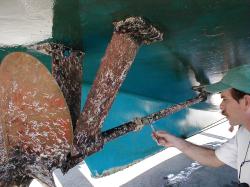If you get as far as expecting the bottom of a boat, we can assume that the rest of the boat appeals to you. Your surveyor can give you the best advice on the condition of the bottom, but there are some things you can visually inspect yourself.
- Bottom Paint – Look for heavy build up of bottom paint. As the paint gets thicker, it is more prone to flaking off as the attachment to the fiberglass becomes weaker. Check to see if strainers have been painted over – impeding the function of water intakes. Also check the boot top paint. This will often need repainting.
- Cutlass bearings – A sign of a bad cutlass bearing will probably be picked up on a sea trial by the noise it makes. While the boat is out of the water grab the prop and try to move it from side to side. There should be no play in it at all. See if there is rubber “oozing” out of the bearing. It is not necessarily bad if you hear squeaking or squealing when turning the prop while the boat is out of the water as these bearing rely on water for lubrication.
 Props – Look for nicks or bends in the blades of the props. Check the color. If there is a red tint to the bronze then the zincs have not been changed as necessary. Electrolysis will pull the zinc out of the bronze leaving the prop (or other bronze surface) brittle.
Props – Look for nicks or bends in the blades of the props. Check the color. If there is a red tint to the bronze then the zincs have not been changed as necessary. Electrolysis will pull the zinc out of the bronze leaving the prop (or other bronze surface) brittle.- Keel – Inspect the keel for signs of repair. Any good repair shouldn’t be readily noticeable. The surface should be fair. After the boat has been out of the water for a while there should be no more water “weeping” out of the keel. Look underneath of the keel. This area is often covered with barnacles if the bottom painting was not done properly or if the boat has been run aground.
- Blistering – This subject is beyond the scope of this discussion and should be left to your surveyor. The best time to see blisters is when the boat is coming out of the water. As the bottom begins to dry, the blisters will recede leading to a false inspection. Your surveyor will use a moisture meter to determine whether the fiberglass is retaining moisture. Blistering is not usually found on boats which spend a season out of the water every year as the hull has enough time to release any moisture. Repairing isolated blistering is not an expensive job but larger scale blistering will be very expensive.
OYA T&T Suggested Bottom Enhancements:
- Spurs Line Cutters – Line cutters actually use the propeller’s action to cut any lines that become entangled on your prop. They also help prevent burnt bearings and engine overloads as well as saving expensive haul-outs.
 Props – Look for nicks or bends in the blades of the props. Check the color. If there is a red tint to the bronze then the zincs have not been changed as necessary. Electrolysis will pull the zinc out of the bronze leaving the prop (or other bronze surface) brittle.
Props – Look for nicks or bends in the blades of the props. Check the color. If there is a red tint to the bronze then the zincs have not been changed as necessary. Electrolysis will pull the zinc out of the bronze leaving the prop (or other bronze surface) brittle.
